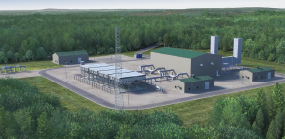The INGAA Foundation Inc. commissioned ENSR International (ENSR), an environmental consulting firm, to undertake a study to identify potential solutions to conflicts that sometimes arise between regional, federal, state, local, and/or tribal governing entities when siting, constructing, and maintaining interstate natural gas pipelines. This study was conducted between March and December 2004.
According to a recent INGAA Foundation Study, United States (U.S.) natural gas consumption should approach 30 Trillion cubic feet by the end of the next decade if the supply of gas is developed. If this growth in consumption is to occur, however, large amounts of infrastructure, including pipeline capacity, storage capacity, and liquified natural gas terminal capacity, must be built in the U.S. and Canada.
The Federal Energy Regulatory Commission (FERC) must approve all new interstate natural gas pipelines and any expansions to existing interstate natural gas systems, including storage fields and liquid natural gas (LNG) import facilities. The FERC approval process includes the appropriate National Environmental Policy Act (NEPA) review as well as verification that applicants obtain permits from numerous federal, state and local agencies before construction may begin. However, coordinating agency efforts has remained a significant challenge to the project approval process; consumers and pipeline project sponsors alike have benefited from streamlining initiatives that have occurred in the past couple of years. Still, more improvements on this front could even further streamline project permitting and reduce unnecessary project delays without compromising existing environmental review and compliance.
In this study, "intergovernmental conflicts" were defined as disagreements encountered between two or more regulatory or permitting agencies or entities when reviewing a proposed natural gas infrastructure project. This study focused primarily on intergovernmental conflicts between federal, state, local, or tribal permitting entities (also referred to in this report as Federal versus state conflicts, state versus state, Federal versus tribal, et cetera). These disagreements were as simple as conflicting permit review timeframes or as complicated as what specific mitigation was required when the project encountered highly erodible soils during construction.
The scope of work for the study included four steps: preliminary issue identification by evaluating project case studies; a comparison of the permitting process for interstate natural gas pipelines against other similar industries; a literature review for previously stated solutions and existing legislation, and finally, recommended solutions or strategies for conflict avoidance and resolution.
This study began with an examination of the nature and extent of conflicts that arose between the FERC and other agency jurisdictions relative to both new capital projects and existing systems’ maintenance projects. The study reviewed natural gas pipeline projects planned and/or constructed over the past decade to determine the nature of any intergovernmental conflicts and their effect on the projects, as well as identify successful permitting strategies.
Various impediments were encountered by the proposed pipelines in the case studies. The impediments included resource constraints at the state agency level; resistance by state or local agency staff to performing a concurrent review with the federal permit review; differences in the allowed resource impacts and required mitigation for a project; intragency conflicts, wherein various staff within an agency disagreed and caused impediments to the process; and purposeful delay by agency staff for reasons other than related to the permit (i.e., political reaction to public or personal opposition to the project). For projects that crossed tribal lands, the negotiations with the tribal entities required more time, more attention, and more costly lease arrangements than anticipated.
The effects of the permitting conflicts studied invariably increased the costs of the project, often delayed the construction schedule, and/or affected the eventual success or failure of the project (i.e., whether or not the project was built). Furthermore, the permitting conflicts affected not only the proposed projects, but also negatively affected the siting of future pipeline projects. For example, project proponents that encountered project "failures" (i.e., projects that were cancelled due to permitting conflicts) on one project were discouraged from siting a future project in the same region, fearing similar permitting failures.
If project proponents continue to avoid siting projects in a certain region of the country due to contentious permitting issues, the result could be a lack of pipeline infrastructure in a particular region, constraining the ability of supply to reach markets. This will impede the industry’s ability to supply demand and lead to higher prices borne by the end user.
Suggestions for addressing these conflicts included additional funding to augment staff needs from either cost recovery programs or third-party funding; permit process and industry training programs, development of both project-specific and industry-wide public outreach programs, awareness by the applicants when proposing projects in states that require more attention and commitment than the federal permitting process; and employing as many other strategies as possible to speed the overall permitting process.
The second step of the study summarized lessons learned outside the natural gas industry. This step reviewed permitting timeframes, intergovernmental conflict potential, and permitting processes (i.e., permit streamlining techniques) in other kinds of infrastructure projects, including wind energy, electric transmission, liquids pipelines, power plants, oil and gas development, and telecommunications. There was a similar amount of regulatory review overlap for these other industries as for the natural gas pipeline industry, since compliance with NEPA is common among them. As such, many of the same permitting impediments occurred in these projects as were encountered with natural gas pipeline projects. These included inadequate staffing at the agency for processing permit applications and lack of knowledge by the agency staff regarding the federal permitting process and/or the industry needs and constraints. Additionally, the other industries encountered communication difficulties between the agencies and the applicant, a lack of communication and coordination between the agencies; misunderstanding regarding what defines a complete application; lack of knowledge by the project applicant regarding the permit process; inconsistent application steps; and permit requirements across agencies or offices within an agency, deadlines and timeframes that were not properly communicated to the applicant, and deadlines and timeframes which differ by agency.
There were many suggestions for addressing these conflicts, employed by both the natural gas pipeline industry and the other industries. These included the establishment and use of predesignated utility corridors; specific review timeframes for completeness and for approval or denial of permit; minimum filing checklists or content rules for applications; use of third-parties to prepare permits or NEPA documents; project-specific resources cost-recovery programs; and project management by a designated lead staff member. Some additional solutions or strategies that appeared to be specific to the natural gas pipeline industry included reference to and implementation of easily recognized best management practices or resource protection documents; use of the FERC pre-filing process; use of third-party compliance monitors for construction; process and application-specific training workshops; and development of a federal interagency memorandum of understanding for interstate natural gas pipeline projects.
The third step of the study involved a literature review to identify permit streamlining strategies and solutions currently in practice and to review relevant federal and state statutes and regulations that attempt to facilitate permitting processes. Of particular note should be the strides that the Federal Highway Administration has made in streamlining their permitting processes within the U.S. Permitting large highway transportation projects is similar to permitting large interstate natural gas pipeline transportation projects in many ways. Provisions in existing Federal Highway Administration legislation could serve as a model for a similar piece of legislation for natural gas pipeline projects in order to address coordinated and concurrent federal and state agency environmental review processes, to create a dispute resolution process, and provide states with the authority to request funds to reimburse affected agencies for expenses.
The study concluded with a comprehensive evaluation of various permit streamlining strategies that attempt to avoid or address intergovernmental conflicts. Recommendations for using these strategies follow the evaluations. These solutions and strategies were organized in the framework of four categories: federal programs, state programs, tribal processes, and applicant practices. The solutions were intended to be fully sustainable (economically viable, environmentally sound, and socially acceptable). These strategies potentially can be employed by both the industry and the regulatory agencies when siting, constructing, and maintaining interstate natural gas pipeline infrastructure. Tables ES-1 through ES-4 summarize the recommended strategies and solutions.



